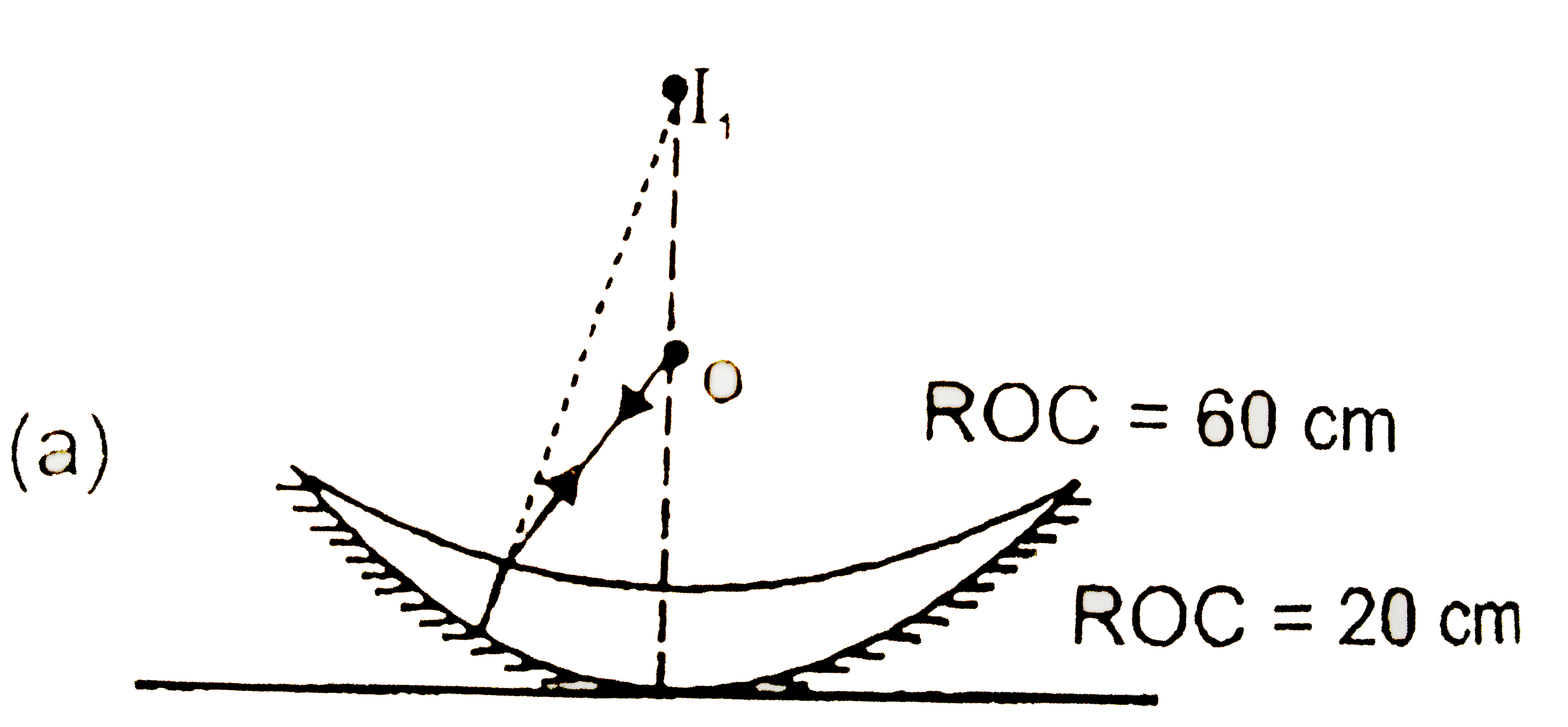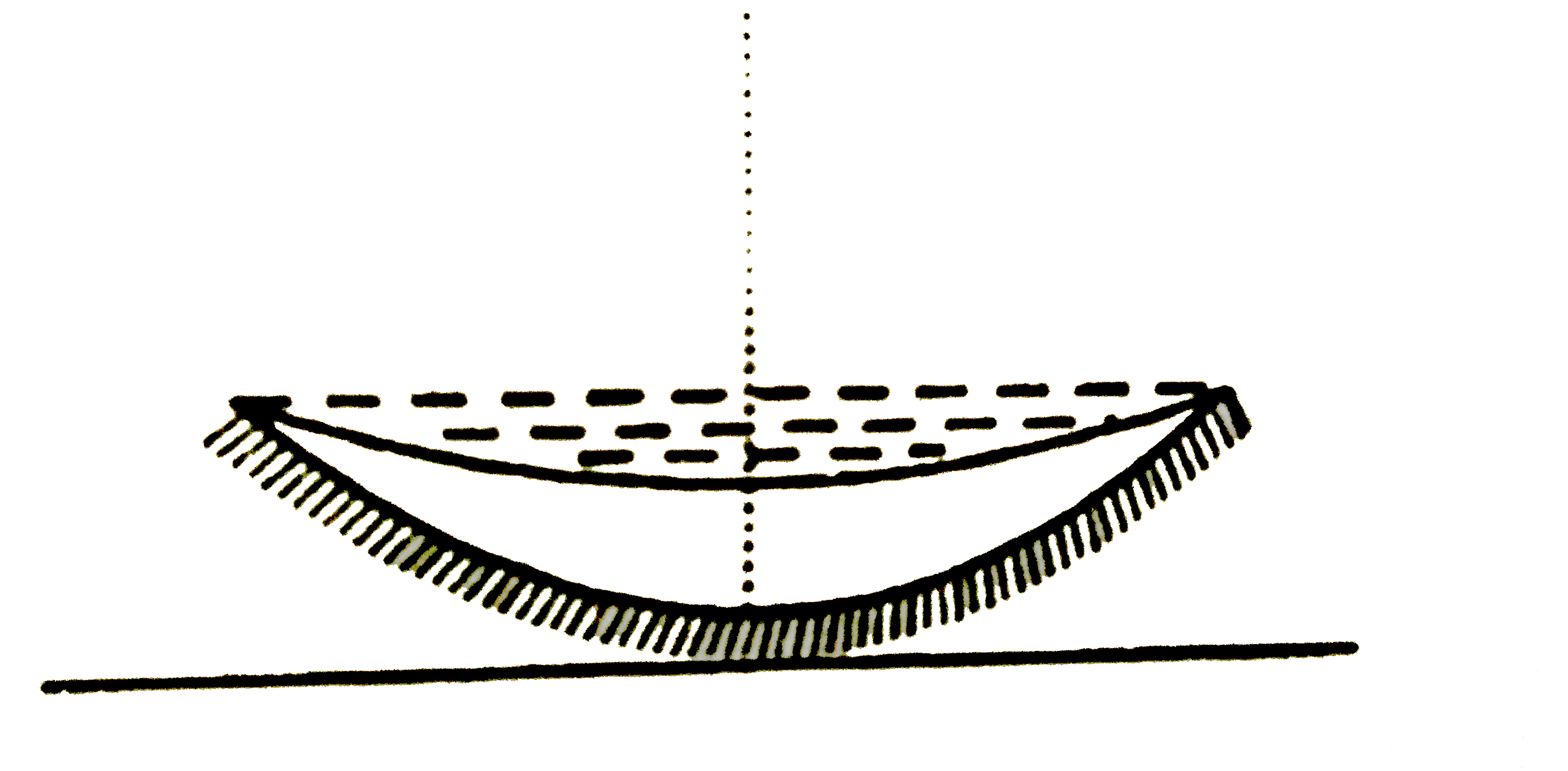The convex surface of a thin concave-convex lens of glass of refractive index 1.5 has a radius of curvature 20 cm. The concave surface has a radius of curvature 60 cm. The convex side is silvered and placed on a horizontal surface as shown in figure. (a) Where should a pin be placed on the axis so that its image is formed at the same place ? (b) If the concave part is filled with water (mu = 4/3), find the distance through which the pin should be moved so that the image of the pin again coincides with the pin.

The correct Answer is:(a) 15cm form the lens on the axis (b) 1.14cm towards the lens.

First image should from at centre pf curvature fo mirror after refraction by convave surfaces.
1.5−20−1u=1.5−1−60,1u=1120−1.520=1−9120,u=−1208=−15cm.
(b) After refraction by water lens image should form at 15cm (Answer of part a)
1fwater=1−15−1u=(43−1)(1∞−1−60)
⇒u=−13.86cm
⇒ So, distance through which the pin should be moved =(15−13.86)=1.14cm towards lens.

Topper's Solved these Questions
- BOOK - RESONANCE ENGLISHCHAPTER - GEOMATRICAL OPTICS EXERCISE - Exercise-262videos
GEOMATRICAL OPTICS
- BOOK - RESONANCE ENGLISHCHAPTER - GEOMATRICAL OPTICS EXERCISE - Exercise-380videos
GEOMATRICAL OPTICS
- BOOK - RESONANCE ENGLISHCHAPTER - GEOMATRICAL OPTICS EXERCISE - Problem33videos
GEOMATRICAL OPTICS
- BOOK - RESONANCE ENGLISHCHAPTER - EXPERIMENTAL PHYSICSEXERCISE - PART -II10videos
EXPERIMENTAL PHYSICS
- BOOK - RESONANCE ENGLISHCHAPTER - GRAVITATIONEXERCISE - HIGH LEVEL PROBLEMS16videos
GRAVITATION
Similar Questions
Knowledge Check
- Question 1 - Select One
A double convex lens is made of glass of refractive index 1.55 with both faces of same radius of curvature. Find the radius of curvature required, if focal length is 20cm.
A11cmB22cmC7cmD6cm - Question 2 - Select One
The radius curvature of each surface of a convex lens of refractive index 1.5 is 40 cm. Calculate its power.
A2.5DB2DC1.5DD1D
The convex side of a thin concavo-convex lens of glass of refractive index 1.5 has a radius of curvature of 20cm. The concave surface has a radius of curvature of 60cm. What is the focal length of the lens? The convex side is silvered and placed on a horizontal surface. What is the effective focal length of the silvered lens? The concave part is filled with water with refractive index 1.33. What is the effective focal length of the combined glass and water lens? If the convex side is silvered what is the new effective focal length of the silvered compound lens?
View SolutionThe concave and convex surface of a thin concavo-convex lens of refractive index 1.5 has radius of curvature 50 cm and 10 cm respectively. The concave side is slivered then if the equivalent focal length of the silvered lends is −5xcm then find x.
View SolutionA double convex lens is made of glass of refractive index 1.55 with both faces of same radius of curvature. Find the radius of curvature required, if focal length is 20cm.
View SolutionA double convex lens is made of glass of refractive index 1.55 with both faces of same radius of curvature. Find the radius of curvature required, if focal length is 20cm.
View SolutionA concavo-convex lens is made of glass of refractive index 1.5. The radii of curvature of its two surfaces are 30cm and 50cm. Its focal length when placed in a liquid of refractive index 1.4 is
View SolutionThe plane surface of a plano-convex lens of refracting index 1.5, is silvered. The radius of curvature of curved surface is R. Find the focal length of the mirror thus formed.
View Solution

